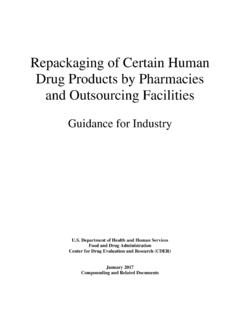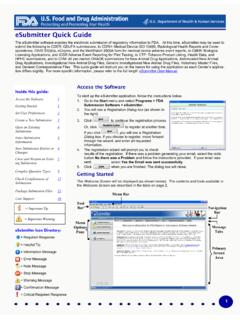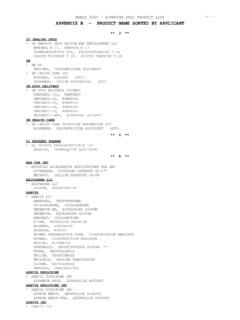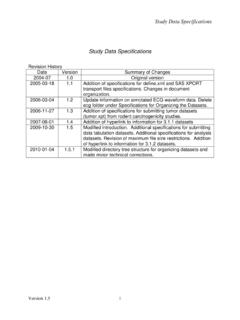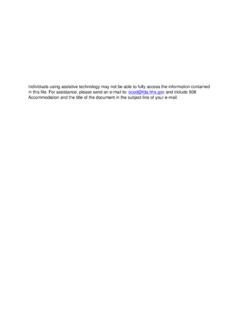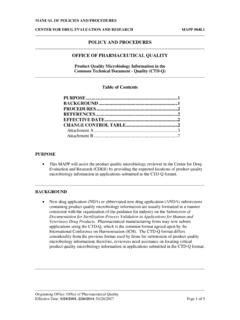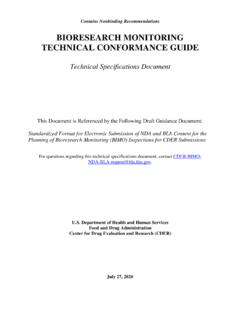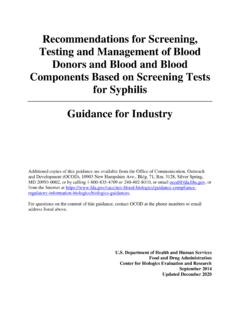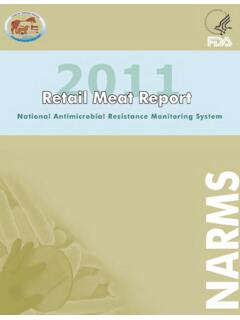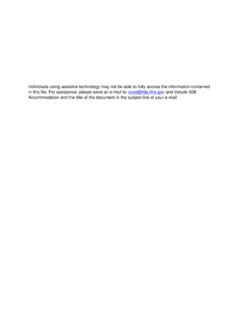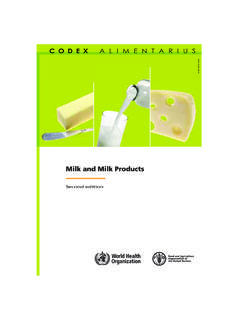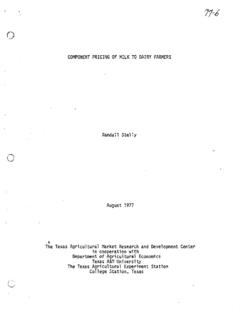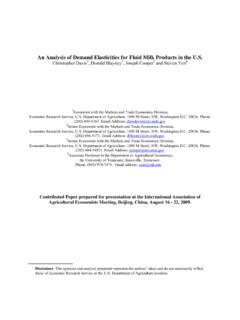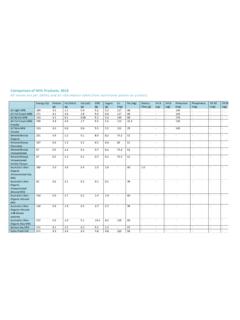Transcription of Milk Memo M-I-18-3 - fda.gov
1 _____ M-I-18-3 1 January 19, 2018 HHS:PHS:FDA:CFSAN:OFS:DDEMP:MMPB:MST 5001 Campus Drive College Park, MD 20740-3835 M-I-18-3 January 19, 2018 TO: Director, Office of State Cooperative Programs Attn: All Staff, Division of milk Safety FROM: milk and milk Products Branch (HFS-316) SUBJECT: Answers To Questions Received From The Field; Regional milk Seminars; And FDA Training Courses Held During Fiscal Year 2016 Following are answers to questions received from the field; Regional milk Seminars; and FDA training courses (Special Problems in milk Protection, milk Plant Sanitation and Inspection, milk Pasteurization Controls and Tests, and Dairy Farm Sanitation and Inspection) held during fiscal year 2016.
2 In accordance with procedures established through the National Conference on Interstate milk Shipments (NCIMS), if an answer to these questions results in a new understanding of a long-standing situation or installation, and the condition as it exists does not present an immediate public health hazard, reasonable judgment should be exercised and adequate time provided for modification and correction. An electronic version of this memorandum is available for distribution to FDA milk Specialists, Regulatory/Rating Agencies, Laboratory Evaluation Officers and milk Sanitation Rating Officers in your area. The electronic version should be widely distributed to representatives of the dairy industry and other interested parties.
3 It will also be available on the FDA Web Site at at a later date. If you would like an electronic version of this document prior to it being available on the FDA Web Site, please e-mail your request to Robert F. Hennes, RS, MPH CAPT, Public Health Service milk and milk Products Branch _____ M-I-18-3 2 January 19, 2018 1. PMO; Methods of Making Sanitation Ratings of milk Shippers and the Certifications/Listings of Single-Service Containers and/or Closures for milk and/or milk Products Manufacturers (MMSR); and Procedures Governing the Cooperative State-Public Health Service/Food and Drug Administration Program of the National Conference on Interstate milk Shipments (PROCEDURES) IMS-a-50 (Supplement 1)-Effective Date Stayed for Joint Council (JC) Proposals 3, 4, 5 and 7 from the 2015 NCIMS Conference was issued May 9, 2016.
4 It provided for milk Sanitation Rating Officers (SROs) and FDA milk Specialists (MSs) to exercise discretion on ratings and check ratings, respectively, by not debiting milk plants on the provisions of JC Proposals 3, 4, 5 and 7 until the extended compliance date of September 17, 2018 as established by FDA in Federal Register (FR) Notices published on September 17, 2015 and November 18, 2015. a) Is this a stay on the NCIMS request to NOT debit during ratings and check ratings OR that all the referenced actions will be stayed for both Enforcement Ratings (ERs) and Sanitation Compliance Ratings (SCRs) until September 17, 2018? Both. b) Also, the 2015 PMO incorporated the new language into the new Item 15p(C) and the existing Appendix K-HACCP Program; will compliance with these actions also be stayed where States officially adopt the 2015 PMO by reference?
5 Yes. c) What are FDA s recommendations related to this stay for SROs and FDA MSs when they are conducting ratings and check ratings, respectively, prior to September 17, 2018? FDA is recommending that SROs during ratings and FDA MSs during check ratings only ask milk plant management how they are addressing JC Proposals 3, 4, 5 and 7 and DO NOT debit the milk plant for non-compliance until the FDA extended compliance date of September 17, 2018. NOTE: The answers provided above also apply to Proposals JC-2 and JC-4 passed at the 2017 NCIMS Conference, which addressed aligning the PMO with the requirements of the Food Safety Modernization Act s (FSMA) Final Rule for Preventive Controls for Human Food (PCHF).
6 Proposals JC-2 and JC-4 made changes to the 2015 NCIMS Conference JC Proposals that were passed and established an effective date of September 17, 2018. _____ M-I-18-3 3 January 19, 2018 2. PMO; MMSR; and PROCEDURES JC Proposal 1 from the 2015 NCIMS Conference added the following to Section 7-Standards for Grade A Pasteurized, Aseptically Processed and Packaged Low-Acid milk and/or milk Products, and Retort Processed after Packaging Low-Acid milk and/or milk Products: The Grade A PMO, with Appendices, and the supporting milk plant-specific procedures required herein, shall constitute a milk plant s food safety plan as required by 21 CFR to the extent that the procedures address all the hazards identified by the milk plant as applicable for that milk plant.
7 A milk plant shall have a written Hazard Analysis for each kind or group of milk and/or milk product processed. IMS-a-50 (Supplement 1) provides for SROs and FDA MSs to exercise discretion on ratings and check ratings, respectively, by not debiting milk plants on the provisions of JC Proposals 3, 4, 5 and 7 until the extended compliance date of September 17, 2018 as established by FDA in Federal Register (FR) Notices published on September 17, 2015 and November 18, 2015. Does this approach and stay addressed in Question 1 above also apply to JC Proposal 1? Yes. 3. PMO-Sections 1 and 4 If rennet is being added to sour cream as part of the culturing process, is it required that rennet be declared in the ingredient statement on the sour cream label?
8 Yes. The Standard of Identity (SOI) for sour cream provides for the addition of rennet. If rennet is added, it shall be declared in the ingredient statement on the principal display or information panel of the sour cream label. 4. PMO-Sections 1 and 4; and Appendix L a) A milk plant that utilizes batch (vat) pasteurization wishes to add the term "Low Heat" or "Low Heat Pasteurization" on the labels of their Grade A milk and milk products. Wouldn t the use of these terms Low Heat or Low Heat Pasteurization without an explanation of what either of those terms means be considered to be misleading to the consumer? The following answers were provided by CFSAN s Office of Nutrition and Food Labeling (ONFL): Yes.
9 "Low Heat" or Low Heat Pasteurization are not defined in the CFR, so they are an undefined labeling term. Unless their labels are going to asterisk _____ M-I-18-3 4 January 19, 2018 those terms and then explain someplace on the label what "Low Heat" or Low Heat Pasteurization means, it would be misleading to the consumer. b) Would "Vat Pasteurized at 145 F" be acceptable labeling? Yes. 5. PMO-Sections 1 and 4; and Appendix L A milk plant wishes to process a whole milk product with butterfat, instead of the standard and label the whole milk product as Whole milk Plus . Would there be any issues with doing this and labeling the product as such? The following answer was provided by CFSAN s ONFL: The use of the standardized term milk on the Principle Display Panel (PDP) of the labeled container is subject to the SOI found in 21 CFR milk .
10 This SOI requires that the milk contain not less than milkfat, but does not set a maximum milkfat percent. It would be acceptable for the PDP to declare the amount of milkfat present, , in order to distinguish it from other milk that may contain various milkfat levels meeting this SOI. The nutritional information on the nutritional panel of the container label would also need to reflect the correct amount of milkfat in the product . The use of the term Plus to describe this standardized food, milk , is not acceptable, since it may mislead consumers to conclude that this milk or milk product is different or superior to other standardized milk or milk products that comply with 21 CFR The only exception under Section 4-Labeling of the PMO addressing the label of a Grade A milk or milk product is if Whole milk Plus was the trade marked name of the milk or milk product .
